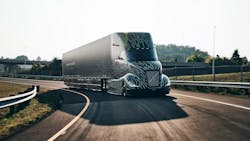Inspiration and empowerment. Those are two good words to describe the Department of Energy’s SuperTruck program. Started in 2009, the program set high freight efficiency goals for OEM teams to achieve. DOE was not looking for incremental changes but rather wanted sweeping improvements. In the book Built To Last, these were called Big Hairy Audacious Goals.
Setting big goals can sometimes free people’s imaginations and creativity and allow them to consider ideas that otherwise would have been dismissed as “too out there.” I believe this is what happened with the SuperTruck program.
What’s interesting is that the SuperTruck 1 teams not only met their goals but greatly exceeded DOE’s expectations by increasing freight-ton efficiency by well over 50% with tractor-trailers easily exceeding 10 mpg.
SuperTruck 1 was such a success that the White House and DOE initiated a SuperTruck 2 program in 2016. As part of the SuperTruck 2 program, OEMs were again required to share the costs. And SuperTruck 2 had even more aggressive goals than SuperTruck 1, including a greater than 100% improvement in vehicle freight efficiency (on a ton-mile-per-gallon basis) relative to a 2009 baseline. The five SuperTruck 2 teams all exceeded that goal, showcasing performance up to 16 mpg.
See also: SuperTruck 2 tech to benefit ZEVs: NACFE report
While exceeding goals in a demonstration is great, what’s even better is being able to have some of the technologies used to exceed those goals implemented in actual trucks. The SuperTruck program is doing that. Truck makers took some of the things they learned from SuperTruck 1 and incorporated them into their production models. Some priority technologies they found that achieve greater gains include aerodynamic improvement, rolling resistance improvement, weight reduction, and parasitic loss reduction.
OEMs have introduced or are introducing some changes in these areas with little to no fanfare and making them part of the standard spec because of the benefits they bring to the truck owner. I am excited to see how SuperTruck 2 learnings will make production trucks even better than they are today.
Another important thing about the improvements realized by the SuperTruck 2 teams is that the technologies can be used on trucks regardless of the fuel source. Therefore, while a given technology can allow a diesel-powered truck to travel farther on a gallon of diesel, that same technology can add range to a battery-electric truck, allowing it to travel more miles before needing to be charged.
Based on the success of the first two SuperTruck programs, SuperTruck 3 launched in 2021 and has a broader focus that is looking at electrified medium- and heavy-duty trucks and freight system concepts to achieve higher efficiency and zero emissions.
It’ll be interesting to see what the big takeaways are and how they can be leveraged to make trucking even more efficient.
I can’t wait to see what we learn from the five teams that were awarded the funding, and I'm even more excited to see how SuperTruck 2 learnings will make production trucks even better than they are today.
About the Author

Michael Roeth
Executive Director
Michael Roeth is the executive director of the North American Council for Freight Efficiency. He serves on the second National Academy of Sciences Committee on Technologies and Approaches for Reducing the Fuel Consumption of Medium and Heavy-Duty Vehicles and has held various positions with Navistar and Behr/Cummins.
